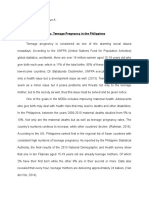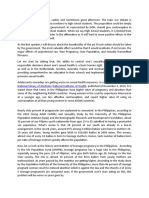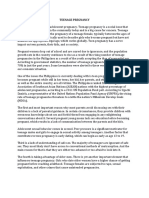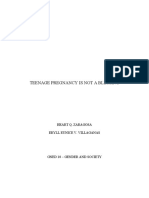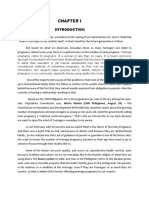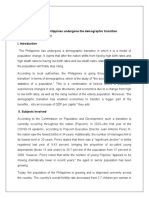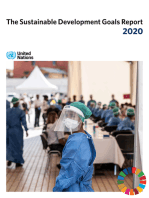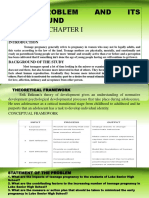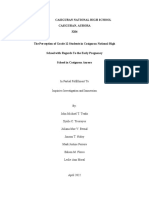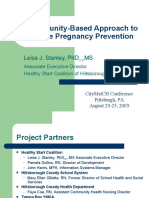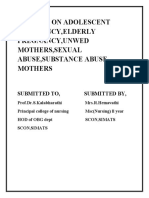MIL
MIL
Uploaded by
Chares MarucutCopyright:
Available Formats
MIL
MIL
Uploaded by
Chares MarucutOriginal Title
Copyright
Available Formats
Share this document
Did you find this document useful?
Is this content inappropriate?
Copyright:
Available Formats
MIL
MIL
Uploaded by
Chares MarucutCopyright:
Available Formats
Teenage Pregnancy: Philippines Great Crisis
Teenage pregnancy has been a great crisis our world is facing today. Its cases are increasing
each year. Every year, approximately 12 million girls aged between 15 to 19 years, and at least 777,000
girls under 15 years give birth in every developing regions of the world. Across Asia the Philippines has
the highest number of teen pregnancy cases. The number of pregnant children below 15 in the
Philippines has doubled in the past 10 years, according to POPCOM. Multiple partners and low condom
use were some factors for the increase in birth rate.
In 2018 pregnancies among children 10 to 14 years old went up to 2,200 more than doubled the
1000 recorded in 2007.juan Antonio Perez III, POPCOM’s Executive Director explained that there are 40
to 50, 10-year-old children giving birth every year. The country has recorded a seven percent increase in
teenage birth in 2019 up to the previous rate. The government labelled it a national social emergency in
2019. However the issue has now worsened amid to the coronavirus pandemic.
A report by Save the Children showed that a dramatic surge of teenage pregnancies and child
marriages is expected during pandemic, due to the economic impacts of health crisis. According to
Alberto Muyot, Chief Executive Officer of Save the Children Philippines that early pregnancy robes the
childhood of the teenagers and deprives them of their right to survival, education, and a future. They
are the ones facing the great impact that threatens their lives and destroy their future.
Early pregnancy among adolescents results in major health consequences for young mothers
and their babies, according to the WHO. It is said that pregnancy and childbirth complications are the
leading causes of death among adolescent girls globally, with low- and middle-income countries
accounting for 99% of global maternal deaths of females aged between 15 to 49 years old. Other than
that teenage pregnancies have led to some 3.9 million unsafe abortions among teens aged 15 to 19 per
year, contributing to maternal mortality, morbidity, and lasting health problems.
Back in November 2020, a survey found that 55% of Filipinos think that teenage pregnancy is the
“most important problem of women today” in the Philippines. According to POPCOM at the end of
2020, more than 70,000 families were led by minors. However, the agency warned that it dramatically
rise to over 130,000 by the end of 2021.
So we must give more interest and attention to reproductive healthcare. Contraceptive access
has long been a complicated and divisive problem in the country it is because birth control is a taboo in
the country where 80% of the population are Catholic. Health experts believe it will take years, if not
decades, to change the culture. That’s why education is important to teenagers especially sexual
education. For them to have more information and learnings in that department. We must raise
awareness of sexual and reproductive health. We call the government to implement comprehensive
education on sexuality and relationships both in and out of school like seminars. This could also may
help teens to be more cautious and may help decrease the teenage pregnancy rate in the country.
You might also like
- Teenage PregnancyDocument19 pagesTeenage PregnancyJhong Xyrus94% (48)
- (DOH HPB) PA6 Playbook 2021 - Key Assistance For Developing Adolescents (KADA) NetworkDocument71 pages(DOH HPB) PA6 Playbook 2021 - Key Assistance For Developing Adolescents (KADA) Networkrk100% (1)
- Position Paper The Social Problem of Teenage Pregnancy in The PhilippinesDocument2 pagesPosition Paper The Social Problem of Teenage Pregnancy in The PhilippinesEunice Shyra Bucsit85% (20)
- Childhood Obesity: Causes and Consequences, Prevention and Management.From EverandChildhood Obesity: Causes and Consequences, Prevention and Management.No ratings yet
- The Risks of Teenage PregnancyDocument9 pagesThe Risks of Teenage PregnancyIsrael R. OrtalezaNo ratings yet
- The Pregnant Teen: A Growing Problem?: Share It!Document15 pagesThe Pregnant Teen: A Growing Problem?: Share It!MiyangNo ratings yet
- Teenage PregnancyDocument3 pagesTeenage PregnancyJhon Pol CailaoNo ratings yet
- INTRODUCTION Teenage Pregnancy - Docx MilynDocument2 pagesINTRODUCTION Teenage Pregnancy - Docx Milynprince4hircs4christi100% (7)
- MANILA, Philippines - It's A Breezy Afternoon in A Cold January, But It's Humid As Usual in This BlockDocument6 pagesMANILA, Philippines - It's A Breezy Afternoon in A Cold January, But It's Humid As Usual in This BlockErl D. MelitanteNo ratings yet
- Teenage PregnancyDocument20 pagesTeenage PregnancyRaniel John Avila Sampiano100% (2)
- Reflection Paper On Teenage PregnancyDocument6 pagesReflection Paper On Teenage PregnancyEdcelle Bimbo50% (2)
- Chapter 1Document6 pagesChapter 1Alfred PrimeNo ratings yet
- Teenage PregnancyDocument2 pagesTeenage PregnancyGina Arcala LinNo ratings yet
- Rlo Purposive ComDocument6 pagesRlo Purposive ComLadyvirdi CarbonellNo ratings yet
- Joys and Challenges of Teen PregnancyDocument11 pagesJoys and Challenges of Teen PregnancyMicheal LezondraNo ratings yet
- Adolescent Reproductive Health (ARH) Teenage Pregnancy Prevention AwarenessDocument3 pagesAdolescent Reproductive Health (ARH) Teenage Pregnancy Prevention AwarenessJasmin GallaNo ratings yet
- Eliminating Teenage Pregnancy in The Philippines: Policy BriefDocument6 pagesEliminating Teenage Pregnancy in The Philippines: Policy BriefMari LeianaNo ratings yet
- RRL FinalDocument7 pagesRRL FinalBRIGINO, ALYSSA BERNICE I.No ratings yet
- Rationale Group 1Document5 pagesRationale Group 1Josol AlgorNo ratings yet
- Sample Research Introduction On Teen PregnancyDocument12 pagesSample Research Introduction On Teen PregnancyMARY ANGELICA AQUINONo ratings yet
- Teenage PregnancyDocument1 pageTeenage PregnancyMau DabiNo ratings yet
- Sex Educ and Teen PregnancyDocument10 pagesSex Educ and Teen PregnancyBoy Kakak Toki0% (1)
- Midterm Examination in Purposive Communication: Name: Philipp Louie G. Cabarrubias Year/Section: BSMT-1 GolfDocument4 pagesMidterm Examination in Purposive Communication: Name: Philipp Louie G. Cabarrubias Year/Section: BSMT-1 GolfYoj EscarioNo ratings yet
- Situation AnalysisDocument8 pagesSituation AnalysisKeena Joy Awisan - Pinas100% (1)
- Adolescent Pregnancy: Many Adolescent Girls Between 15 and 19 Get PregnantDocument3 pagesAdolescent Pregnancy: Many Adolescent Girls Between 15 and 19 Get PregnantladyanjaniNo ratings yet
- Aaa SN PsycDocument2 pagesAaa SN Psyckingawesome21No ratings yet
- Cruel Reality: Teenage Pregnancy in The Philippines Leads To Unsafe Abortion and DeathDocument4 pagesCruel Reality: Teenage Pregnancy in The Philippines Leads To Unsafe Abortion and DeathDayson AngelaNo ratings yet
- Teenage PregnancyDocument27 pagesTeenage PregnancyMaricel Ceyh GonzalesNo ratings yet
- Teenage Pregnancy EssayDocument2 pagesTeenage Pregnancy EssayIyahNo ratings yet
- Nursing Research On Early PregnancyDocument15 pagesNursing Research On Early PregnancyMARY ANGELICA AQUINO100% (1)
- SpeechDocument3 pagesSpeechBoy Kakak Toki100% (1)
- RAMISCAL-ST. MARGARET-Teenage PregnancyDocument2 pagesRAMISCAL-ST. MARGARET-Teenage PregnancyArfiele ramiscalNo ratings yet
- Creative Portfolio-Humss12Document29 pagesCreative Portfolio-Humss12Romina CarreonNo ratings yet
- Bakang''S Group Perceptions On Teenage Pregnancy Among Junior Community School at NanogangDocument2 pagesBakang''S Group Perceptions On Teenage Pregnancy Among Junior Community School at NanogangKebalerile Rejoice MokgatleNo ratings yet
- Teenage PregnancyDocument2 pagesTeenage Pregnancyliah rie mendozaNo ratings yet
- Capstone Research 2Document1 pageCapstone Research 2Nora CruzNo ratings yet
- Target OutputDocument1 pageTarget Outputapi-341275251100% (3)
- The Contemporary WorldDocument1 pageThe Contemporary WorldMichelle SisonNo ratings yet
- Editorial and Column Writing 2023Document9 pagesEditorial and Column Writing 2023acedothNo ratings yet
- Teenage Pregnancy Is Not A BlessingDocument15 pagesTeenage Pregnancy Is Not A BlessingEryll Eunice VillaganasNo ratings yet
- Teenage Pregnancy in The PhilippinesDocument5 pagesTeenage Pregnancy in The PhilippinesMarjoe Mejias100% (1)
- Teenage PregnancyDocument24 pagesTeenage Pregnancynievesarianne1No ratings yet
- Teenage PregnancyDocument4 pagesTeenage PregnancyjoannesalagubangNo ratings yet
- Teenage Pregnancy Is The Biggest Problem Women and Girls Face in The PhilippinesDocument3 pagesTeenage Pregnancy Is The Biggest Problem Women and Girls Face in The PhilippinesVon VeraNo ratings yet
- Teenage IntroDocument1 pageTeenage IntroVerna Santos GarchitorenaNo ratings yet
- Tcwd-Group-7-Case-Study RevDocument29 pagesTcwd-Group-7-Case-Study RevKristine PangahinNo ratings yet
- Chapter 1Document10 pagesChapter 1Reynel Torres CabilbilNo ratings yet
- RH, Population and Climate Change Challenge People Count, PLCPD Policy Brief, October 2012Document16 pagesRH, Population and Climate Change Challenge People Count, PLCPD Policy Brief, October 2012Floreen SimonNo ratings yet
- Review Related Studies Related To Teenage Pregnancy (Foreign)Document44 pagesReview Related Studies Related To Teenage Pregnancy (Foreign)ruth ann solitarioNo ratings yet
- Teenage Pregnancy - Docx 20240514 005523 0000Document20 pagesTeenage Pregnancy - Docx 20240514 005523 0000alexanderlodriguito28No ratings yet
- Research Paper EARLY PREGNANCYDocument11 pagesResearch Paper EARLY PREGNANCYMaria Concepcion TuvillaNo ratings yet
- Background of The StudyDocument3 pagesBackground of The StudyKeena Joy Awisan - Pinas87% (23)
- Chapter 1Document10 pagesChapter 1Jonathan Delos Reyes100% (2)
- Global TransitionDocument3 pagesGlobal TransitionMarinelle AtienzaNo ratings yet
- Chapter 1Document4 pagesChapter 1Faisal Tuazon IINo ratings yet
- Research PapertDocument9 pagesResearch Papertjethro sasiNo ratings yet
- Fact SheeeeeetDocument3 pagesFact SheeeeeetB12- Rosero, Ronnie Jr, B.No ratings yet
- Popcom Says Teenage Pregnancy in Philippines Still AlarmingDocument6 pagesPopcom Says Teenage Pregnancy in Philippines Still AlarmingJennifer R. JuatcoNo ratings yet
- Philippines Undergone Demographic TransitionDocument3 pagesPhilippines Undergone Demographic TransitionNEBRIAGA, MARY S. 3-2No ratings yet
- Article Philo1Document5 pagesArticle Philo1Leticia Rose SunicoNo ratings yet
- The Sustainable Development Goals Report 2020From EverandThe Sustainable Development Goals Report 2020No ratings yet
- Tafelberg Short: The Politics of Pregnancy: From 'population control' to women in controlFrom EverandTafelberg Short: The Politics of Pregnancy: From 'population control' to women in controlNo ratings yet
- Paper Research Title DefenseDocument10 pagesPaper Research Title DefenseJhon Ryan Diaz JusayanNo ratings yet
- Age of Marriage PDFDocument30 pagesAge of Marriage PDFsaeedpathanNo ratings yet
- Awareness in Teenage PregnancyDocument24 pagesAwareness in Teenage PregnancyEdwardJohnG.CalubII60% (5)
- ImmoralityDocument21 pagesImmoralityagyapong892No ratings yet
- Early Motherhood: A Qualitative Study Exploring The Experiences of African Australian Teenage Mothers in Greater Melbourne, AustraliaDocument11 pagesEarly Motherhood: A Qualitative Study Exploring The Experiences of African Australian Teenage Mothers in Greater Melbourne, AustraliaMayiz GNo ratings yet
- English Quarter 4 Week 6: Capsulized Self-Learning Empowerment ToolkitDocument9 pagesEnglish Quarter 4 Week 6: Capsulized Self-Learning Empowerment ToolkitFionyNo ratings yet
- Eng ResearchDocument22 pagesEng Researchyuan salayogNo ratings yet
- DED SPPAMC Briefer 1Document71 pagesDED SPPAMC Briefer 1Arlyn AyagNo ratings yet
- As You Sow So Shall You ReapDocument3 pagesAs You Sow So Shall You ReapPhilip John JonesNo ratings yet
- Teen Pregnancies Feature WritingDocument1 pageTeen Pregnancies Feature WritingMcMasterPro GeniusNo ratings yet
- Powerpoint in ResearchDocument11 pagesPowerpoint in ResearchGrace AbanillaNo ratings yet
- Nepal - PosterDocument1 pageNepal - Posterapi-258644447No ratings yet
- Casiguran National High School Casiguran, Aurora 3204: in Partial Fulfillment To Inquiries Investigation and ImmersionDocument24 pagesCasiguran National High School Casiguran, Aurora 3204: in Partial Fulfillment To Inquiries Investigation and ImmersionMerry Kriss Estosata RiveraNo ratings yet
- Breaking - The - Cycle - of - Edn - AlienationDocument228 pagesBreaking - The - Cycle - of - Edn - Alienationhasnat basirNo ratings yet
- Ediang - Eng 241 - Act. 6Document8 pagesEdiang - Eng 241 - Act. 6Belstar EdiangNo ratings yet
- Teenage PregnancyDocument24 pagesTeenage PregnancyGladys GaleraNo ratings yet
- Hills Cnty. Healthy Start-Community Based Pregnancy PreventionDocument13 pagesHills Cnty. Healthy Start-Community Based Pregnancy PreventionJoyNo ratings yet
- National Sexual and Reproductive Health PolicyDocument75 pagesNational Sexual and Reproductive Health PolicyBarbara StangenNo ratings yet
- RKSK Operational FrameworkDocument150 pagesRKSK Operational FrameworkSelina Christian 57No ratings yet
- Pretest - S.Y 2023 2024Document10 pagesPretest - S.Y 2023 2024Ma. Maureen DariaNo ratings yet
- Teen Pregnancy Prevention ProgramsDocument31 pagesTeen Pregnancy Prevention Programsqasarq100% (1)
- Social and Psychological Problem of Underage Mothers: Uc MohranoDocument43 pagesSocial and Psychological Problem of Underage Mothers: Uc MohranohabibNo ratings yet
- Research 2Document4 pagesResearch 2Angelo GarinoNo ratings yet
- Lesson Plan M3Document8 pagesLesson Plan M3Lore Jane GalletoNo ratings yet
- Discipline and Ideas in Applied Social SciencesDocument15 pagesDiscipline and Ideas in Applied Social SciencesRhonalyn Mantolino MendozaNo ratings yet
- Teen Pregnancy: Developing Countries' Perspective Vs Developed Countries' PerspectiveDocument6 pagesTeen Pregnancy: Developing Countries' Perspective Vs Developed Countries' PerspectiveLorraine LeeNo ratings yet
- The Reality in Teen Pregnancy Copy 2Document55 pagesThe Reality in Teen Pregnancy Copy 2Junelly Grace TecsonNo ratings yet
- Seminar On Adolescent PregnancyDocument16 pagesSeminar On Adolescent PregnancyMonika shankar100% (2)










